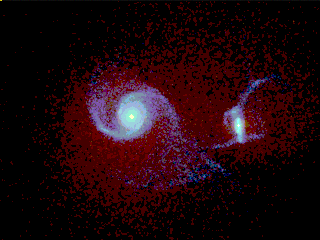 Galaxies --- | ---
Large Scale Structure
Galaxies --- | ---
Large Scale Structure

 Galaxies --- | ---
Large Scale Structure
Galaxies --- | ---
Large Scale Structure

 Reading:
Reading:
Chapter 22 (ZG4)
Notes:
pages 93-96
 |
Key Question: | How far away are the galaxies? |
|---|---|---|
 |
Key Principle: | The Hubble relation v = H*d |
 |
Key Problem: | To find useful cosmological distance indicators |
 |
Key Discovery: | The Universe is Expanding! |
One of the most crucial measurements in astronomy is that of finding the distance to a particular object, be it a planet, star, galaxy, quasar, or cluster of galaxies. The use of Cepheid variable stars for distances in the galaxy was discussed in Lecture 20. As Cepheids have an absolute magnitude of M_v ~ -6 or fainter, these are good in our galaxy, and to relatively nearby galaxies (100 Mpc at most). We need a distance ladder to take us out into the far extragalactic reaches of space.
Relations between the size, luminosity, mass, and internal velocities provide us with some of our most useful distance indicators. Known as the Tully-Fisher relation for spirals, and the Faber-Jackson relation for ellipticals, these empirical relations between the observed Doppler line widths and the true luminosity of a galaxy allow us to use it as a standard candle.
For an explanation of these relations, see the following resources:
In summary:
To determine the physical properties of galaxies, we first need to find the distance to any given galaxy we wish to study. We use distance indicators to find the distance. Galaxies are so far away that there is no hope of using a direct method such as parallax. We must resort to other distance indicators, many of which are approximate. To quote distances to galaxies, we use the unit megaparsec, Mpc, which is 10^6 pc.
The primary distance indicators for nearby galaxies are variable stars such as Cepheids and RR Lyrae stars. The period-luminosity relation for these stars can be calibrated from observations of variable stars in our own galaxy. Unfortunately, these stars are relatively faint, with absolute visual magnitudes of -6 or fainter. Thus, with a powerful telescope with a limit of apparent magnitude 24, we can see out to
or d = 10 Mpc. In addition, for distant galaxies the variable stars are lost in the myriad of other bright stars. One of the main goals of the Hubble Space Telescope was to measure Cepheid variables in galaxies out to the Virgo cluster (see below) at a distance of around 20 Mpc. The results from this study have been published this last year, and give us our best measurements to galaxies this far away.
Supernovae are also used as distance indicators. These can be seen much further away since they have absolute magnitudes from -16 to -20. Both Type I supernovae and the fainter Type II have been used. There is a general relation between the time it takes a supernova to fade a given number of magnitudes and its intrinsic luminosity, which makes these objects useful as distance indicators.
Other objects or approximately known intrinsic brightness are also used, and the distance deduced from the distance modulus. These indicators are called standard candles. Examples of bright objects used as standard candles are planetary nebulae, H II regions, the brightest O and B stars in galaxies, and surface brightness fluctuations in galaxies caused by the brightest stars, and the brightness of globular clusters. These have not very high accuracies because there is no good way to get the intrinsic luminosities of these things, and they come in a range of luminosities.
Other methods which sort of involve standard candles are the relationships between the maximum rotation velocity of a spiral galaxy disk and the luminosity of the galaxy (the Tully-Fisher relation) and between the central velocity dispersion and the central surface brightness of an elliptical galaxy (the Faber-Jackson relation). When calibrated on nearby galaxies with Cepheid distances, these two relations are the main distance indicators for galaxies from 10 to 100 Mpc away.
The intrinsic luminosities of galaxies themselves make poor standard candles, but when there are many galaxies in a group or cluster all at the same distance, then the brightest galaxies do have approximately the same luminosity. This is a distance indicator of the last resort, due to its large error bar.
Object of a known size can be used as distance indicators through the small angle formula for the apparent angular size versus distance. These are called standard yardsticks (I guess metersticks would be more appropriate). Examples of these are the angular diameters of globular clusters or galaxies.
The final distance indicator is the Doppler velocity of a distant galaxy. This discovery by Hubble in 1929 really set the stage for cosmology.
 Prev Lecture ---
Prev Lecture ---
 Next Lecture ---
Next Lecture ---
 Astr12 Index ---
Astr12 Index ---
 Astr12 Home
Astr12 Home
smyers@nrao.edu Steven T. Myers